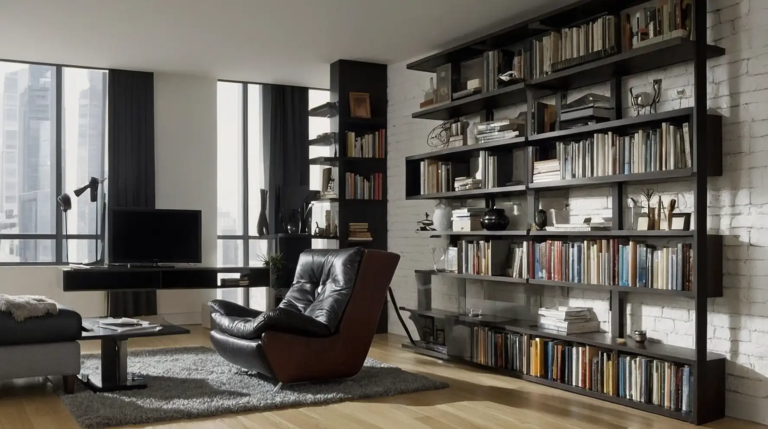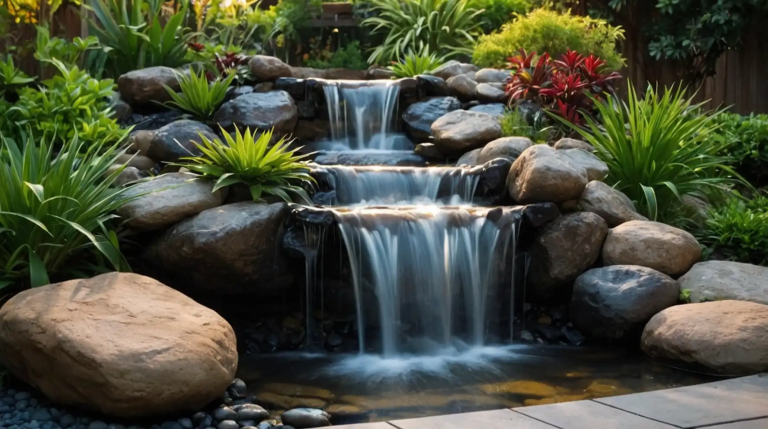27 Stunning Garden Edging Ideas (Define Your Yard in Style)
Garden edging creates clean lines between different landscape elements, adding structure and definition to your outdoor space.
Beyond its practical purpose of containing mulch and preventing grass invasion, edging contributes significantly to your garden’s aesthetic appeal.
With countless material options and design approaches, you can find edging solutions that perfectly complement your landscape style.
From rustic and natural to sleek and contemporary, the right border enhances your garden’s overall design.
Let’s explore 27 creative garden edging ideas that will transform your yard from ordinary to extraordinary!
1: Repurposed Wine Bottle Border

Create an eye-catching border by burying wine bottles upside down along garden edges.
This eco-friendly approach adds unexpected color while repurposing items that would otherwise enter the waste stream.
You’ll achieve maximum impact by using bottles with similar colors or creating a planned pattern.
Bury bottles approximately one-third of their length to ensure stability against wind and accidental bumps.
Consider adding solar-powered cork lights in some bottles for magical evening illumination along your garden paths.
2: Natural Stone Stacking
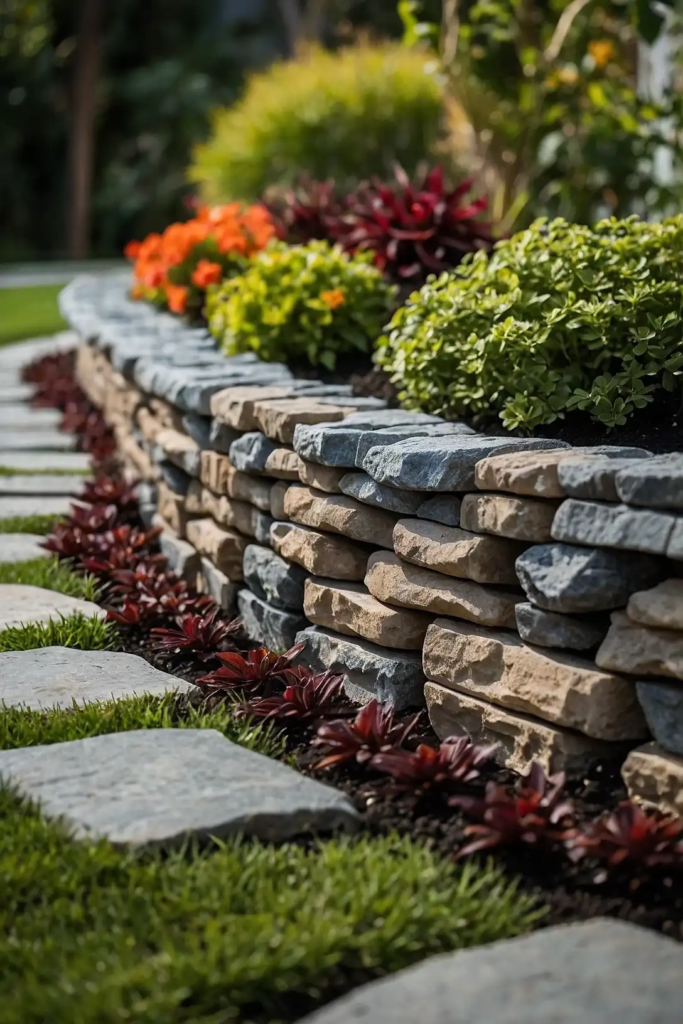
Arrange flat stones of varying sizes in casual stacks along garden borders.
This natural approach creates a rustic, organic edge that complements cottage and woodland gardens beautifully.
You’ll appreciate how this technique follows natural contours and irregular shapes without requiring precise cutting or alignment.
The uneven heights and variable textures add visual interest to your landscape.
Collect stones from your property or source them locally for the most authentic connection to your region’s geology.
3: Living Herb Boundary
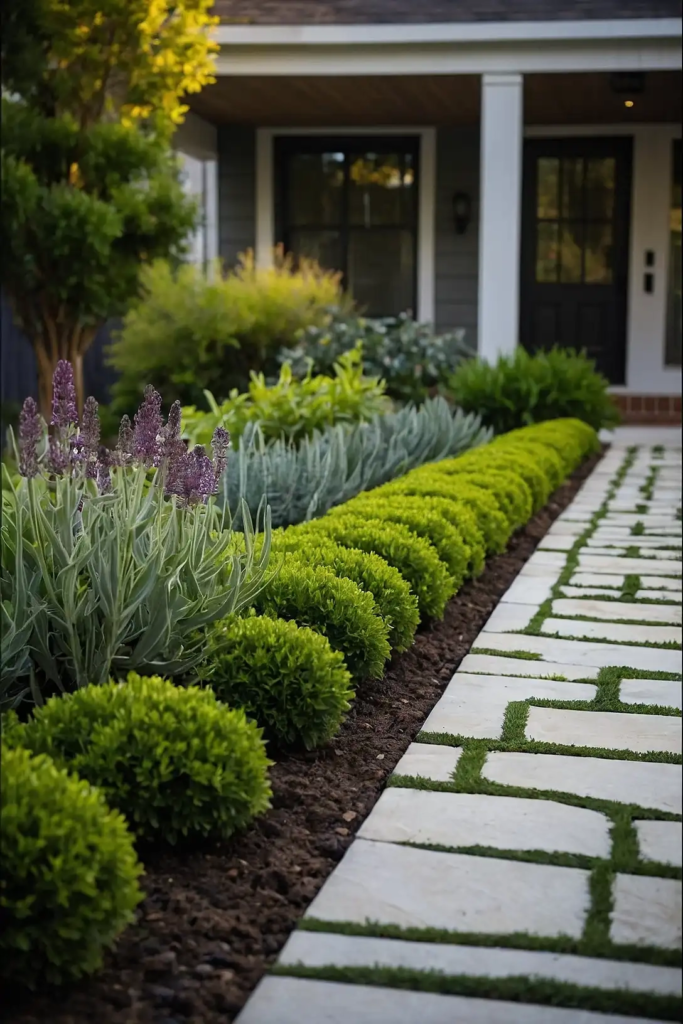
Plant dense, low-growing herbs like thyme, oregano, or chamomile to create functional, fragrant borders. This edible edging solution combines beauty with culinary practicality.
You’ll enjoy aromatic rewards when brushing against these plants while working in your garden.
Different herbs offer various textures, colors, and bloom times for year-round interest.
Position this living edge where you’ll brush against or step on the herbs occasionally, releasing their fragrance throughout your garden experience.
4: Woven Willow Hurdles

Install flexible willow branches woven into low hurdle panels along planting beds.
This traditional technique brings old-world charm and natural texture to contemporary landscapes.
You’ll create a distinctive edge that stands approximately 8-12 inches tall, perfect for containing mulch while remaining visually permeable.
The natural willow color weathers to an attractive silver-gray over time.
Replace panels every few years as they naturally decompose, or preserve them with non-toxic wood oil for extended durability.
5: Vintage Brick Herringbone

Arrange reclaimed bricks in a classic herringbone pattern along garden edges.
This traditional approach adds architectural character while providing excellent durability and definition.
You’ll create crisp lines with historical appeal, particularly effective in cottage or traditional landscape designs.
The varied colors and slight irregularities of vintage bricks add authentic character impossible to achieve with new materials.
Set bricks into soil at a slight angle for maximum stability or mortar them permanently for more formal applications.
6: Modern Steel Edging
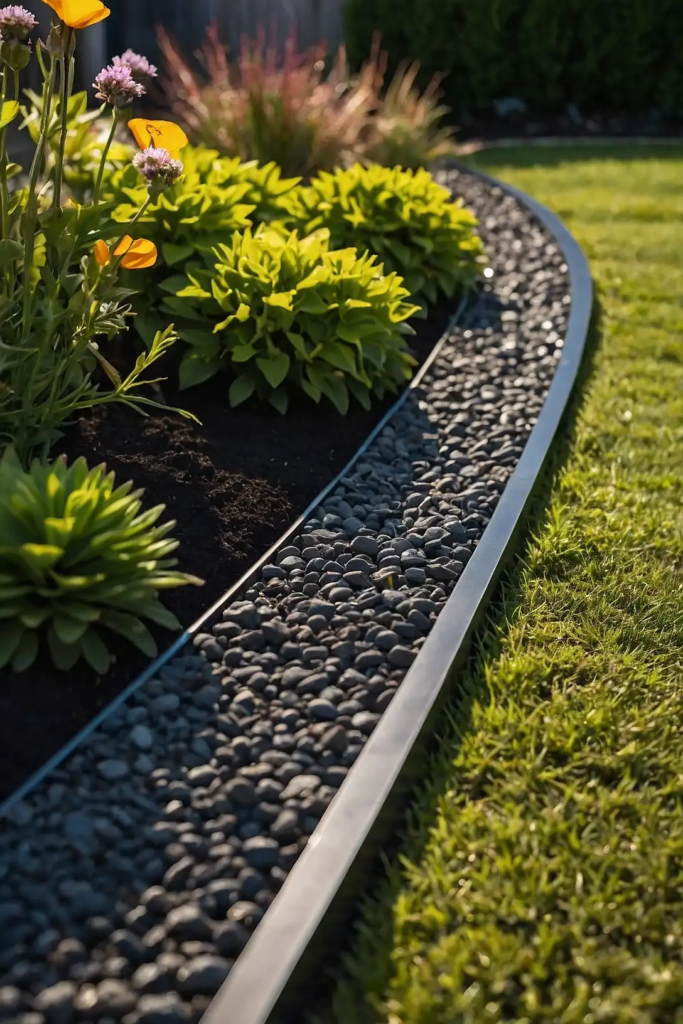
Install sleek steel strips to create clean, minimalist borders between different landscape elements.
This contemporary approach provides exceptional durability with refined aesthetic appeal.
You’ll achieve razor-sharp definition that complements modern architectural styles perfectly.
The thin profile virtually disappears when viewed from above, allowing your plantings to take center stage.
Choose from weathering steel (Corten) that develops a protective rust patina or stainless steel for a consistently sleek appearance.
7: Beach Glass Mosaic
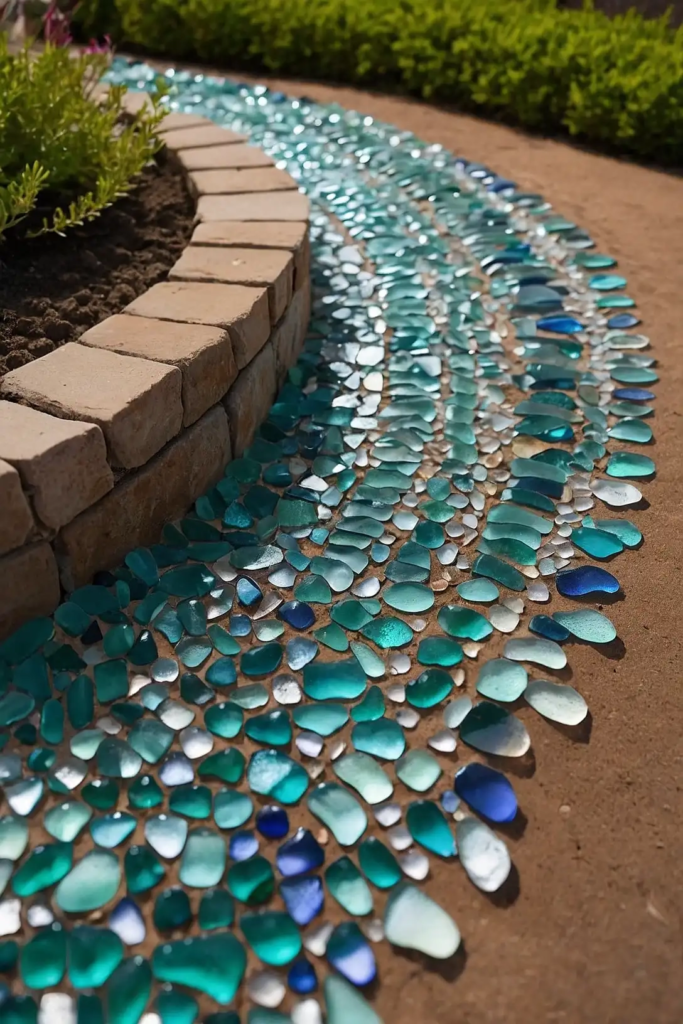
Embed colorful beach glass or tumbled glass pieces into concrete along garden borders.
This artistic approach creates a sparkling, one-of-a-kind edge that catches sunlight beautifully.
You’ll introduce unexpected color and texture while creating a deeply personal landscape element.
The glass pieces can form random patterns or specific designs based on your artistic vision.
Consider using glass colors that complement nearby flowers or your home’s architectural elements for a cohesive design.
8: Log Slice Pathway Edge
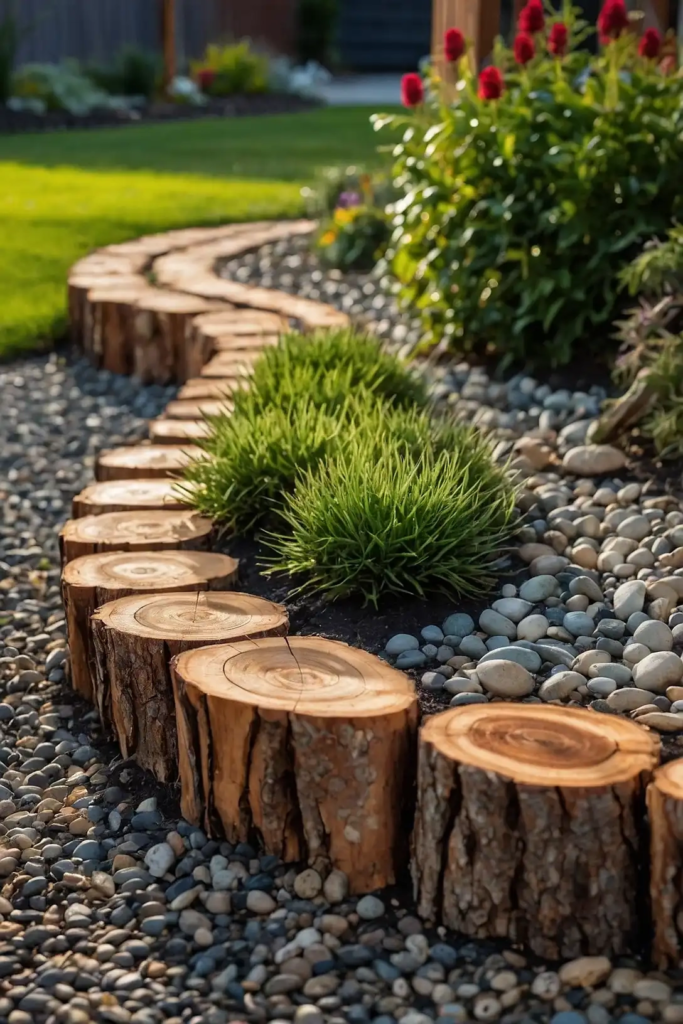
Position round log slices vertically along garden paths or planting beds. This natural approach adds organic texture and woodland character to casual landscape designs.
You’ll create an attractive rhythm with the varying diameters and unique grain patterns of each slice.
Position the logs at consistent depths but allow natural height variations for organic appeal.
Treat the wood with a non-toxic preservative or leave it to weather naturally, knowing you’ll need to replace pieces occasionally as they decompose.
9: Gabion Stone Walls
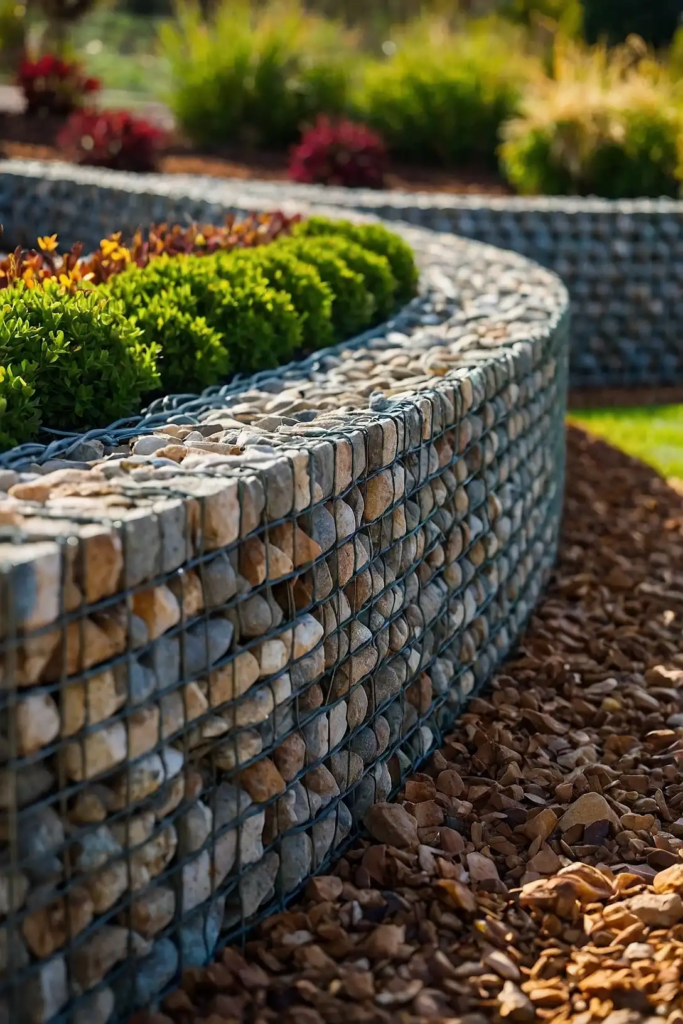
Construct low gabion walls using wire baskets filled with stones as sturdy, contemporary garden edges.
This industrial-inspired approach creates substantial borders with excellent drainage properties.
You’ll introduce strong textural elements that contrast beautifully with soft plantings. The open structure allows some plants to grow within the stone matrix for a living wall effect.
Choose stone colors and sizes that complement your overall landscape design for maximum visual impact.
10: Terracotta Pot Border
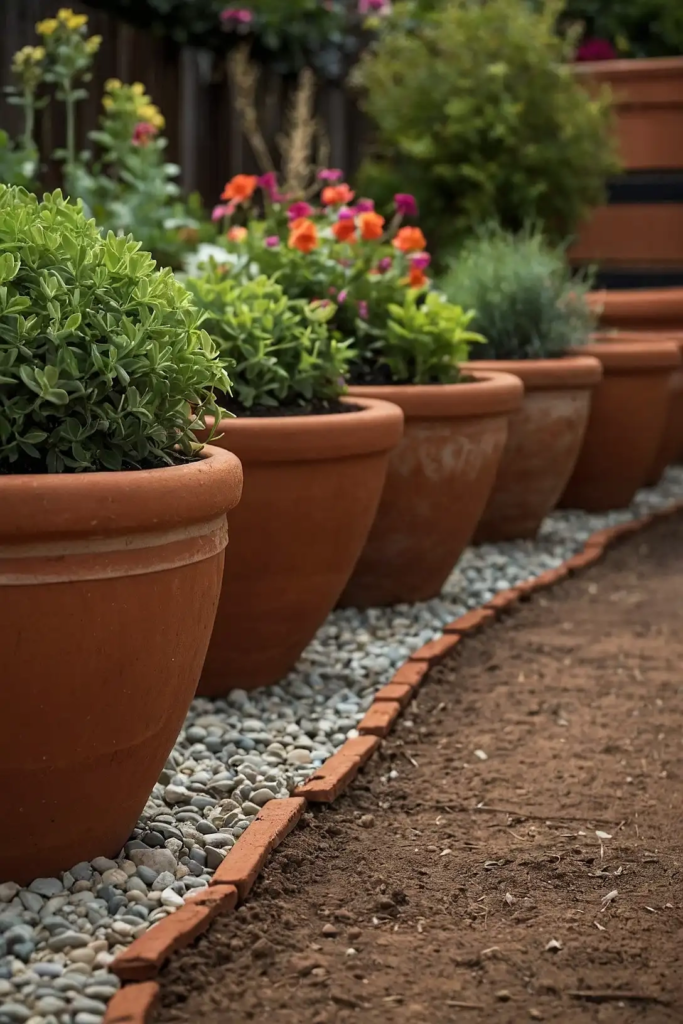
Arrange broken terracotta pots in a continuous scalloped edge along planting beds. This creative recycling approach gives new life to damaged garden containers.
You’ll create a distinctive, sculptural edge with warm earthy colors that complement most garden styles.
The curved forms create a rhythmic visual pattern that softens straight garden lines.
Embed the broken edges approximately one-third into the soil for stability while allowing the curved pot rims to create the visible border.
11: Woven Metal Edging
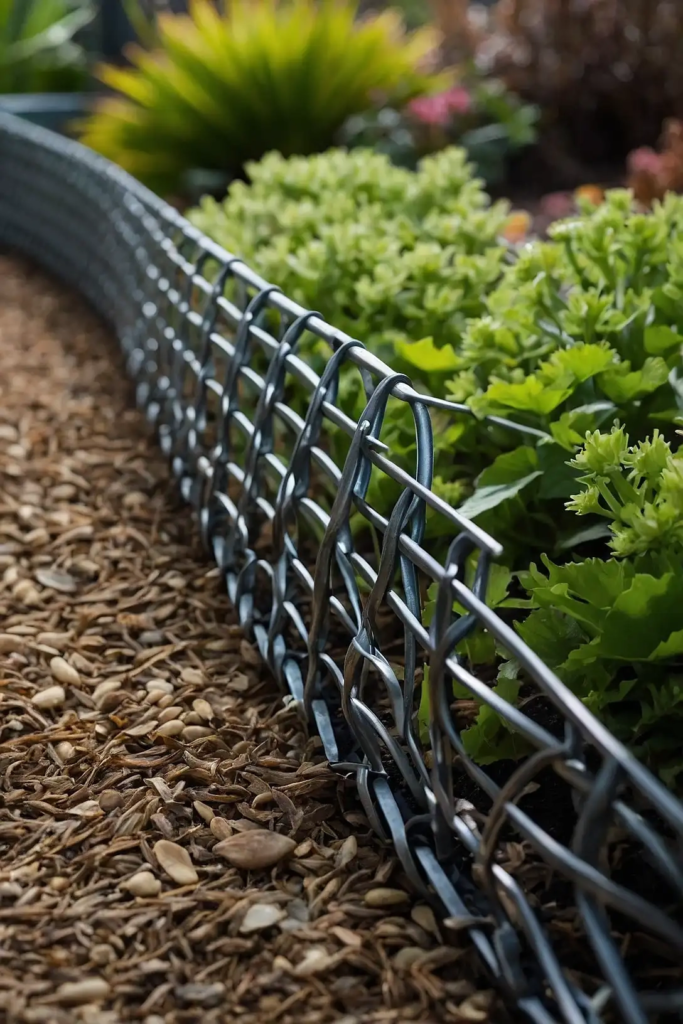
Install flexible metal strips woven through vertical stakes to create an undulating border. This contemporary approach adds visual movement while maintaining modern simplicity.
You’ll achieve a dynamic edge that appears to flow like a ribbon through your landscape.
The reflective quality of metal adds light play to your garden design as sun angles change throughout the day.
Choose aluminum for a bright silver appearance or steel for a darker, more substantial presence in your landscape.
12: Bamboo Roll Border
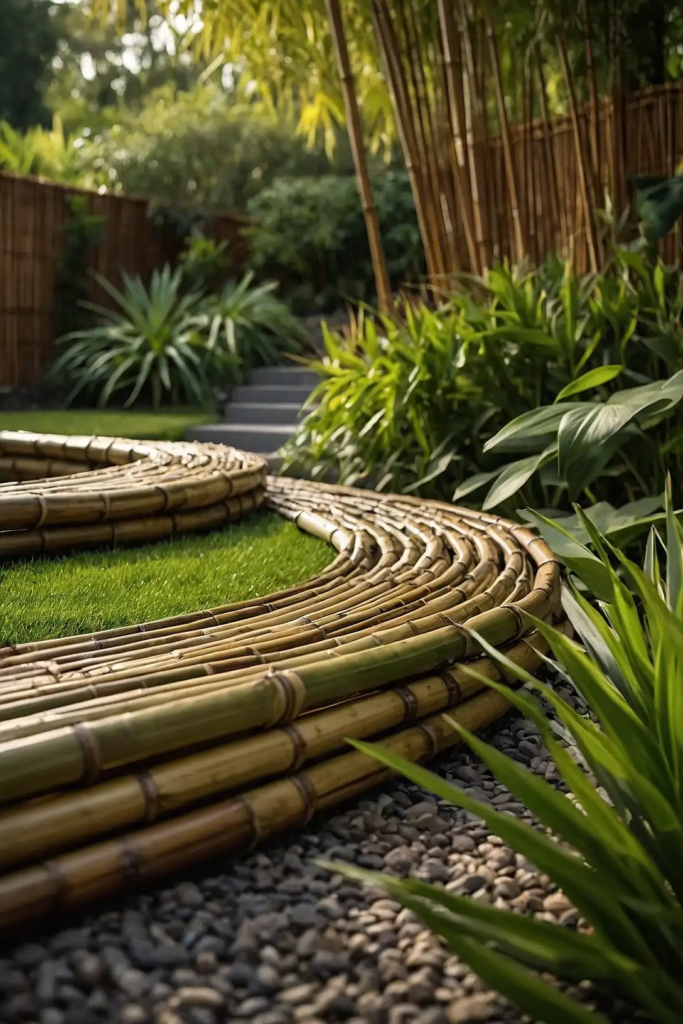
Secure bamboo fence rolls along garden edges for an Asian-inspired natural border.
This approach introduces linear texture and exotic character to contemporary or tropical garden designs.
You’ll create a distinctive edge with natural materials that complement zen or Japanese-inspired landscapes.
The consistent height provides excellent containment for mulch or ground covers.
Consider bamboo with a yellow or black finish to create specific design effects in your overall garden composition.
13: Salvaged Brick Diamond Pattern
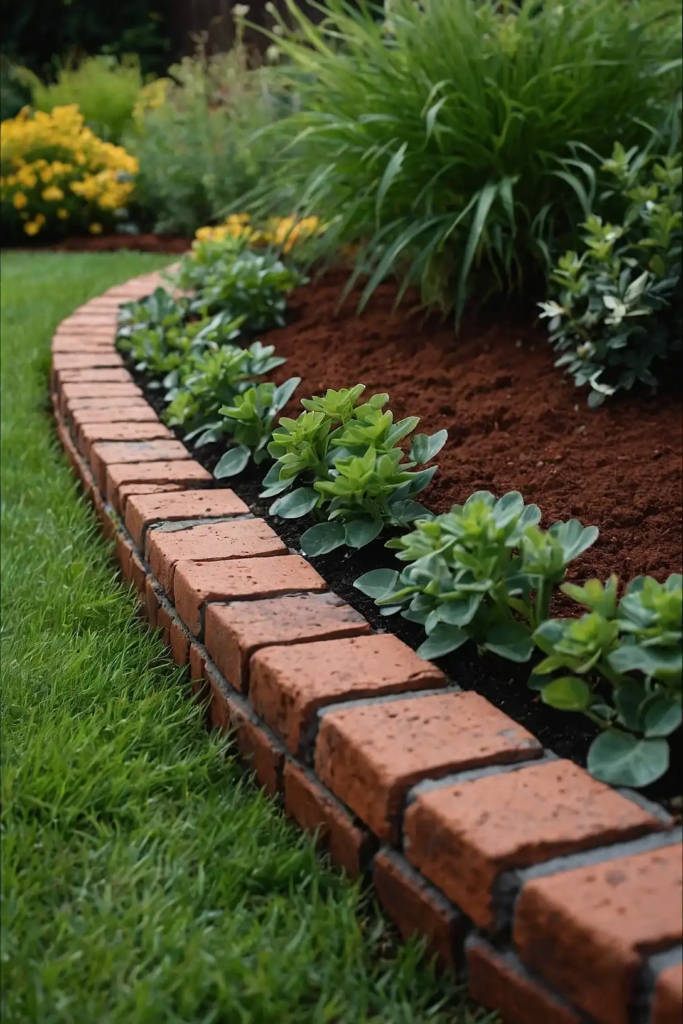
Arrange reclaimed bricks in a diamond pattern along garden borders for architectural interest.
This geometric approach adds classic structure while utilizing sustainable salvaged materials. You’ll create a border with historical character and exceptional durability.
The formal pattern brings order to casual plantings, creating effective visual contrast in your garden design.
Set bricks at a 45-degree angle to the garden edge, allowing the pattern to define the border line with precision.
14: Upright Slate Pieces

Position flat slate pieces vertically along garden edges to create a dramatic natural stone border.
This architectural approach adds strong vertical elements to predominantly horizontal landscapes.
You’ll introduce striking textural contrast between smooth stone faces and surrounding plantings.
The irregular heights and natural color variations create visual interest while maintaining material consistency.
Bury approximately one-third of each piece to ensure stability while allowing the distinctive slate formations to stand proud of the soil.
15: Interlocking Concrete Blocks
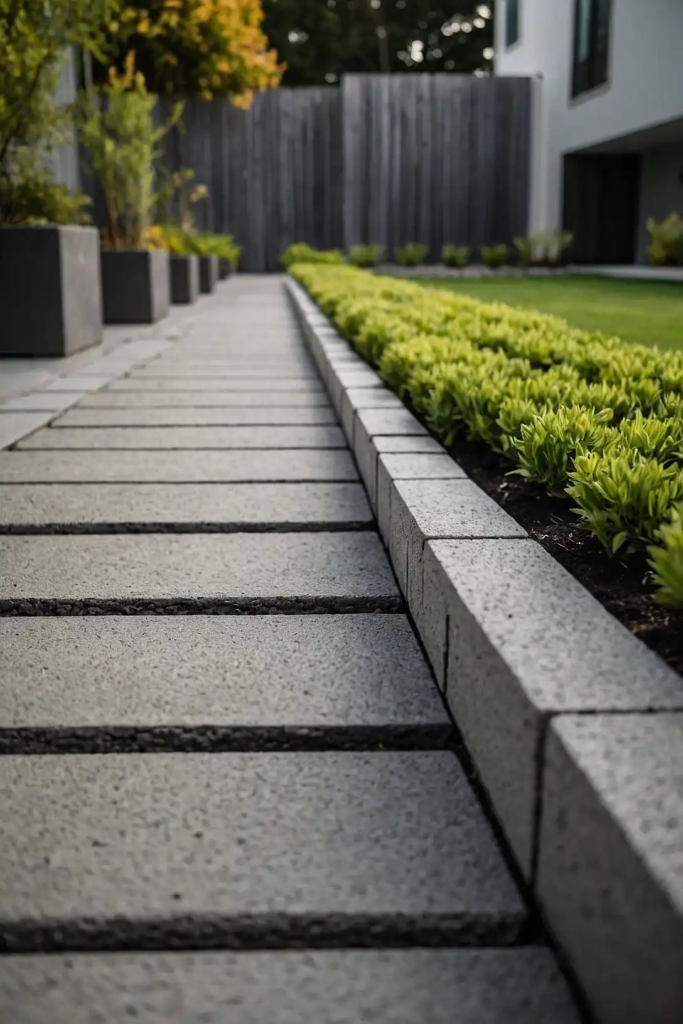
Install specialized interlocking blocks designed specifically for landscape edging.
This practical approach offers excellent durability with various decorative options to match your garden style.
You’ll create a substantial border that effectively contains soil and mulch while preventing grass invasion.
Many systems allow for both straight lines and curved sections to follow your garden’s unique contours.
Choose colors that either blend with your landscape for a subtle edge or contrast deliberately for stronger definition.
16: Wicker Woven Panels

Secure flexible wicker panels along planting beds for a cottage-inspired natural edge.
This traditional approach brings warm texture and artisanal character to your garden borders.
You’ll introduce intricate woven patterns that contrast beautifully with the organic forms of your plantings.
The approximately 10-inch height provides excellent containment for mulch and smaller plants.
Apply a clear sealer to extend the natural material’s lifespan or allow it to weather naturally, replacing sections as needed.
17: Painted Pallet Wood Border
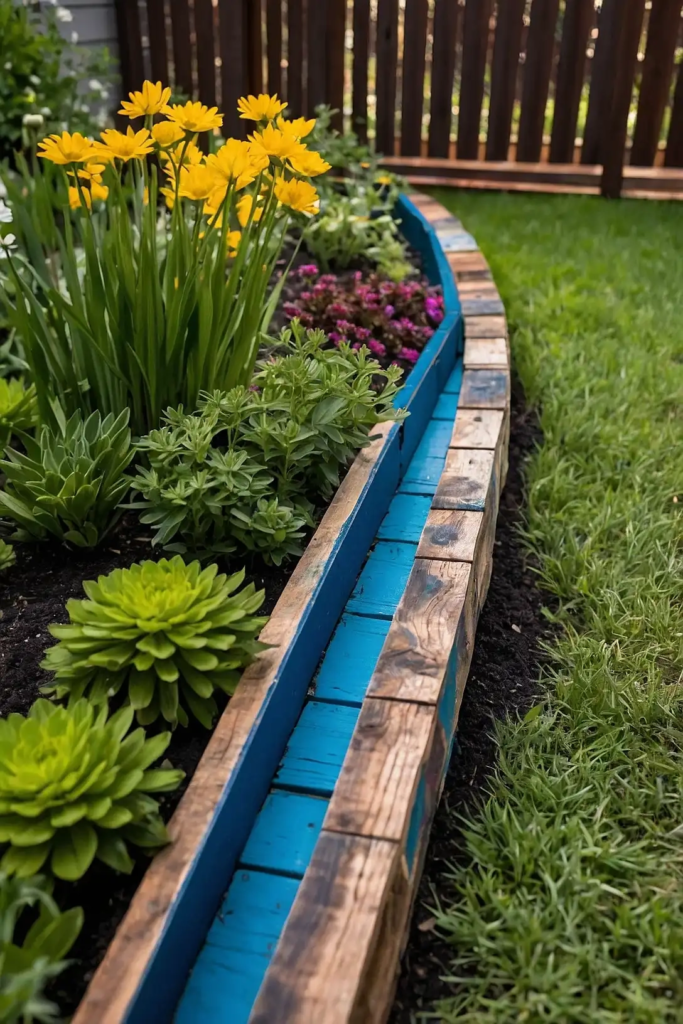
Repurpose wooden pallets into colorful vertical garden edges by cutting and installing individual slats. This upcycling approach adds playful character while preventing waste.
You’ll create a distinctive border that can complement children’s gardens or casual cottage designs.
Paint slats in coordinating colors that reference your home or garden color scheme.
Set each piece at slightly different heights for a whimsical effect or precisely align them for a more structured appearance.
18: Shell-Embedded Concrete
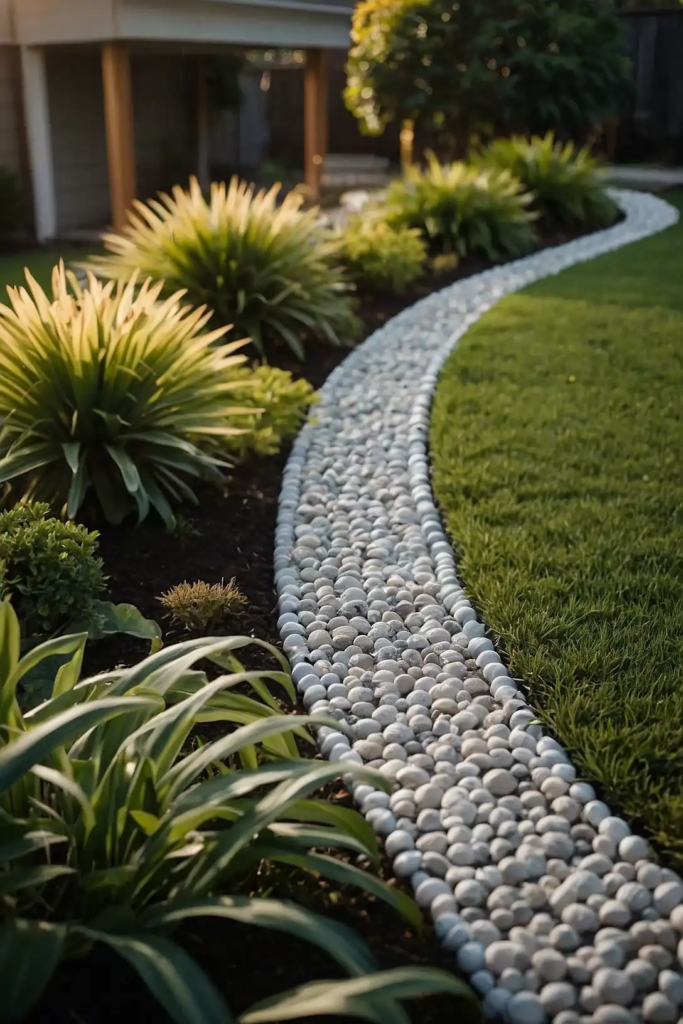
Pour a concrete garden edge with seashells embedded along the top and sides.
This coastal-inspired approach adds unique texture and personal vacation memories to your landscape.
You’ll create a one-of-a-kind border with natural elements that shimmer in changing light conditions.
The durable concrete provides excellent functionality while the shells add decorative interest.
Consider using shells collected from personal travels for a meaningful connection to special places and experiences.
19: Granite Cobblestone Border
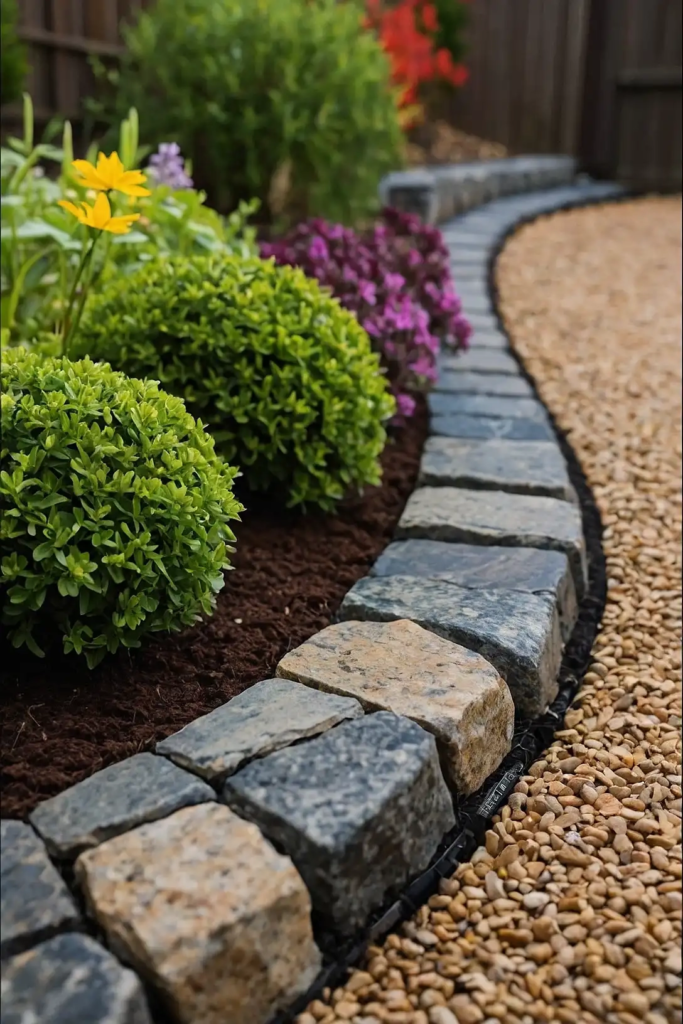
Install reclaimed granite cobblestones in a single or double row along garden edges.
This traditional European technique adds instant age and permanence to new garden installations.
You’ll create a substantial edge with exceptional durability and old-world character.
The natural variations in stone color and texture add visual interest while the consistent size creates rhythmic patterns.
Set stones partially into the soil for a casual effect or mortar them in place for a more formal, permanent installation.
20: Living Willow Edge

Plant willow whips and weave them into living fence structures along garden borders.
This traditional technique creates a border that actually grows and becomes more substantial each year.
You’ll establish a dynamic edge that changes seasonally with new growth, leaf development, and winter branch patterns.
The flexible stems can be continually rewoven to maintain your desired form.
Water newly planted willows frequently until established, positioning them where their moisture-loving nature will be an asset rather than a problem.
21: Rope-Wrapped Log Sections

Position log sections wrapped with natural fiber rope along garden edges. This nautical-inspired approach adds textural interest and rustic character to coastal or casual gardens.
You’ll create a distinctive border that combines natural wood with artisanal rope wrapping techniques.
The natural materials weather together beautifully, developing character over time.
Secure rope with weather-resistant adhesive and replace sections as the natural materials eventually decompose.
22: Recycled Glass Bottle Wall

Construct low walls using glass bottles set in mortar along garden borders. This artistic approach creates stunning light effects while repurposing waste materials creatively.
You’ll introduce brilliant color and light-catching properties that transform throughout the day as sunlight changes angles.
Arrange bottles in patterns or color progressions for maximum visual impact.
Consider using bottles with personal significance or collecting specific colors to complement your overall garden design.
23: Timber Railway Sleepers
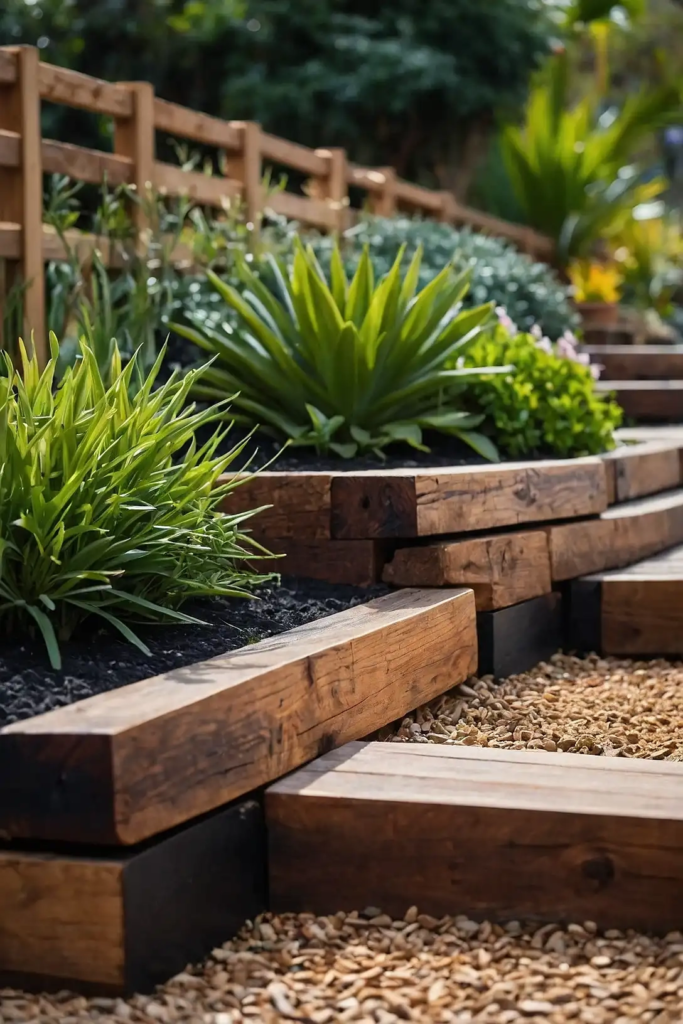
Position reclaimed railway ties horizontally to create substantial garden borders.
This rugged approach adds industrial heritage and exceptional durability to contemporary landscapes.
You’ll establish strong horizontal lines that effectively contain soil while providing casual seating opportunities along garden edges.
The weathered wood brings immediate character to new garden installations.
Select sleepers without creosote treatment for food gardens, using only those with non-toxic preservatives or naturally weathered finishes.
24: Basket Weave Brick Pattern
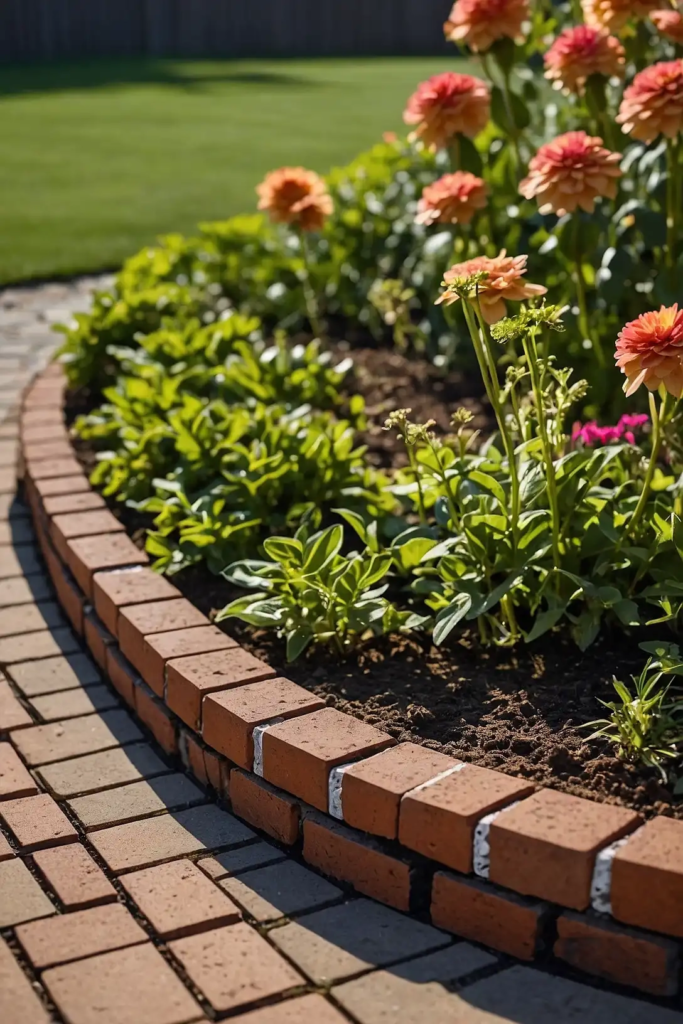
Arrange standard bricks in a classic basket weave pattern along garden edges. This traditional technique adds architectural elegance to formal or cottage garden designs.
You’ll create a distinctive pattern that draws the eye along garden borders while providing excellent durability.
The rhythm of alternating orientations adds visual interest to this practical edge solution.
Set bricks flush with lawn level for easy mowing or slightly raised to create a defined lip that contains mulch effectively.
25: Stained Glass Garden Border
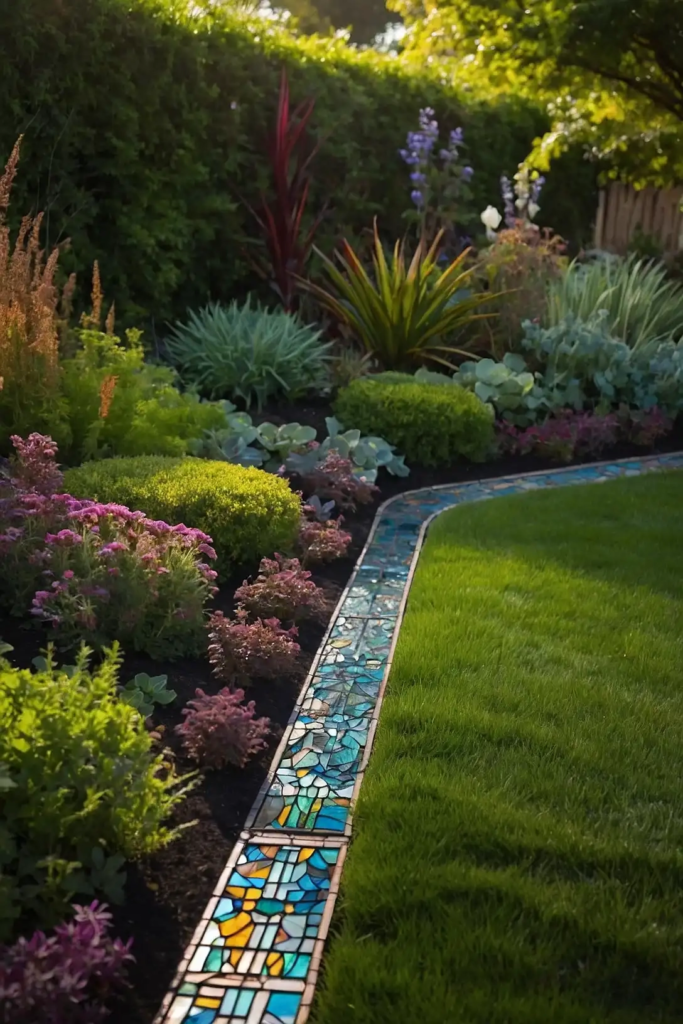
Embed stained glass pieces vertically in concrete to create a luminous garden edge.
This artistic approach creates dramatic light effects while adding unique color to your landscape.
You’ll introduce jewel-like color blocks that glow when backlit by morning or evening sun.
Position this special edge where light will transmit through the glass for maximum impact.
Create simple geometric patterns or elaborate designs based on your artistic abilities and garden style preferences.
26: Woven Copper Pipe Edge
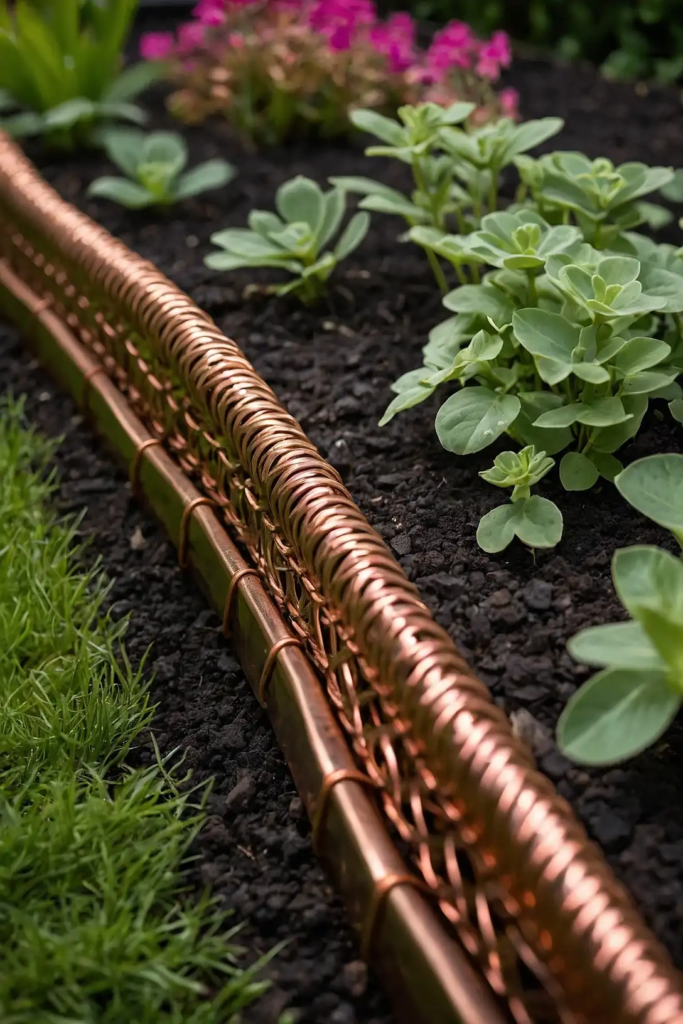
Construct a border using flexible copper pipe woven through vertical copper stakes.
This luxurious approach adds rich metallic color and reflective qualities to contemporary gardens.
You’ll create a distinctive edge that develops beautiful patina over time, evolving from bright penny-copper to subtle verdigris.
The malleability of copper allows for both straight runs and graceful curves.
Position this edge where it will receive afternoon sun that highlights the warm metallic tones against surrounding greenery.
27: Mosaic Tile Border

Create a colorful mosaic tile edge along garden borders using outdoor-rated ceramic tiles.
This artistic approach adds Mediterranean or Mexican-inspired color and pattern to your landscape.
You’ll introduce vibrant personality that complements flowering plants and garden structures.
Set tiles into concrete for permanence, allowing your personal design expression to become a lasting garden feature.
Consider repeating colors from your home’s exterior or garden containers to create cohesive color connections throughout your landscape.
Conclusion
These 27 garden edging ideas offer endless inspiration for defining your outdoor spaces with personality and style.
Experiment with materials that complement your landscape design while providing the practical edge definition your garden needs. Happy gardening!


